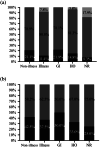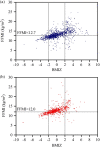Assessment of nutritional status in paediatric outpatients using bioelectrical impedance analysis and anthropometric z-scores
- PMID: 33749969
- PMCID: PMC8451919
- DOI: 10.1111/jpc.15450
Assessment of nutritional status in paediatric outpatients using bioelectrical impedance analysis and anthropometric z-scores
Abstract
Aim: To investigate paediatric outpatients' nutritional status using bioelectrical impedance analysis and anthropometric z-scores.
Methods: A retrospective data analysis of tertiary paediatric hospital outpatients from 2017 to 2019 was conducted. Patients were categorised into three groups (non-illness, illness and simple obesity) according to clinical diagnoses. The nutritional status was evaluated using anthropometric and bioelectrical impedance analysis. In addition, body composition measurements of patients in three subgroups of the illness group and age- and gender-matched healthy controls were compared.
Results: A total of 2015 paediatric outpatients were enrolled. According to body mass index z-scores, undernutrition prevalence among participants was 14.0% (non-illness group, 21.3%; illness group, 11.4%). Body composition measurements indicated that 41.6% of participants had a low fat-free mass index, and the proportions of participants with a low fat-free mass index in the non-illness, illness and simple obesity groups were 48.4, 47.0 and 10.7%, respectively. Compared with healthy controls, the haematology and oncology subgroup had a significantly lower fat-free mass index and fat mass index; the nephrology and rheumatology subgroup had significantly lower height-for-age z-scores but higher fat mass index; and the gastroenterology subgroups had lower fat mass index, fat-free mass index and body mass index z-scores.
Conclusions: The results suggested the low fat-free mass index prevalence was greater than the low body mass index z-score prevalence among paediatric outpatients, and body composition parameters varied across different illnesses. Body composition analysis is recommended in nutrition clinics for accurate paediatric outpatient nutritional assessment, thereby providing timely individualised nutritional interventions.
Keywords: adolescent; anthropometry; body composition; children; nutritional assessment.
© 2021 The Authors. Journal of Paediatrics and Child Health published by John Wiley & Sons Australia, Ltd on behalf of Paediatrics and Child Health Division (The Royal Australasian College of Physicians).
Figures

 ), BMIZ>2; (
), BMIZ>2; ( ), −2≤BMIZ≤2; (
), −2≤BMIZ≤2; ( ), BMIZ<−2. (b) (
), BMIZ<−2. (b) ( ), Normal FFMI; (
), Normal FFMI; ( ), low FFMI.
), low FFMI.
Similar articles
-
Assessment of body composition by bioelectrical impedance in adolescent patients with celiac disease.Am J Gastroenterol. 1999 Oct;94(10):2951-5. doi: 10.1111/j.1572-0241.1999.01443.x. Am J Gastroenterol. 1999. PMID: 10520850
-
Development of bioelectrical impedance-derived indices of fat and fat-free mass for assessment of nutritional status in childhood.Eur J Clin Nutr. 2008 Feb;62(2):210-7. doi: 10.1038/sj.ejcn.1602714. Epub 2007 Mar 14. Eur J Clin Nutr. 2008. PMID: 17356557
-
The nutritional status of healthy children using bioelectrical impedance and anthropometric measurement.J Pediatr (Rio J). 2022 Mar-Apr;98(2):161-167. doi: 10.1016/j.jped.2021.05.009. Epub 2021 Jul 7. J Pediatr (Rio J). 2022. PMID: 34242586 Free PMC article.
-
[Simple obesity in children. A study on the role of nutritional factors].Med Wieku Rozwoj. 2006 Jan-Mar;10(1):3-191. Med Wieku Rozwoj. 2006. PMID: 16733288 Review. Polish.
-
Body composition measurements: interpretation finally made easy for clinical use.Curr Opin Clin Nutr Metab Care. 2003 Jul;6(4):387-93. doi: 10.1097/01.mco.0000078988.18774.3d. Curr Opin Clin Nutr Metab Care. 2003. PMID: 12806211 Review.
Cited by
-
Bioelectrical impedance analysis for measuring body composition and predicting low muscle mass in apparently healthy pediatric outpatients: a retrospective observational study.BMC Pediatr. 2025 Apr 16;25(1):303. doi: 10.1186/s12887-025-05579-8. BMC Pediatr. 2025. PMID: 40241085 Free PMC article.
-
Embracing the Nutritional Assessment in Cerebral Palsy: A Toolkit for Healthcare Professionals for Daily Practice.Nutrients. 2022 Mar 11;14(6):1180. doi: 10.3390/nu14061180. Nutrients. 2022. PMID: 35334837 Free PMC article.
References
-
- Bouma S. Diagnosing pediatric malnutrition: Paradigm shifts of etiology‐related definitions and appraisal of the indicators. Nutr. Clin. Pract. 2017; 32: 52–67. - PubMed
-
- Joosten KF, Hulst JM. Prevalence of malnutrition in pediatric hospital patients. Curr. Opin. Pediatr. 2008; 20: 590–6. - PubMed
-
- Murphy AJ, Hill RJ, Buntain H, White M, Brookes D, Davies PSW. Nutritional status of children with clinical conditions. Clin. Nutr. 2017; 36: 788–92. - PubMed
-
- Mok C, To C, Ma K. Changes in body composition after glucocorticoid therapy in patients with systemic lupus erythematosus. Lupus 2008; 17: 1018–22. - PubMed
Publication types
MeSH terms
Grants and funding
LinkOut - more resources
Full Text Sources
Other Literature Sources

